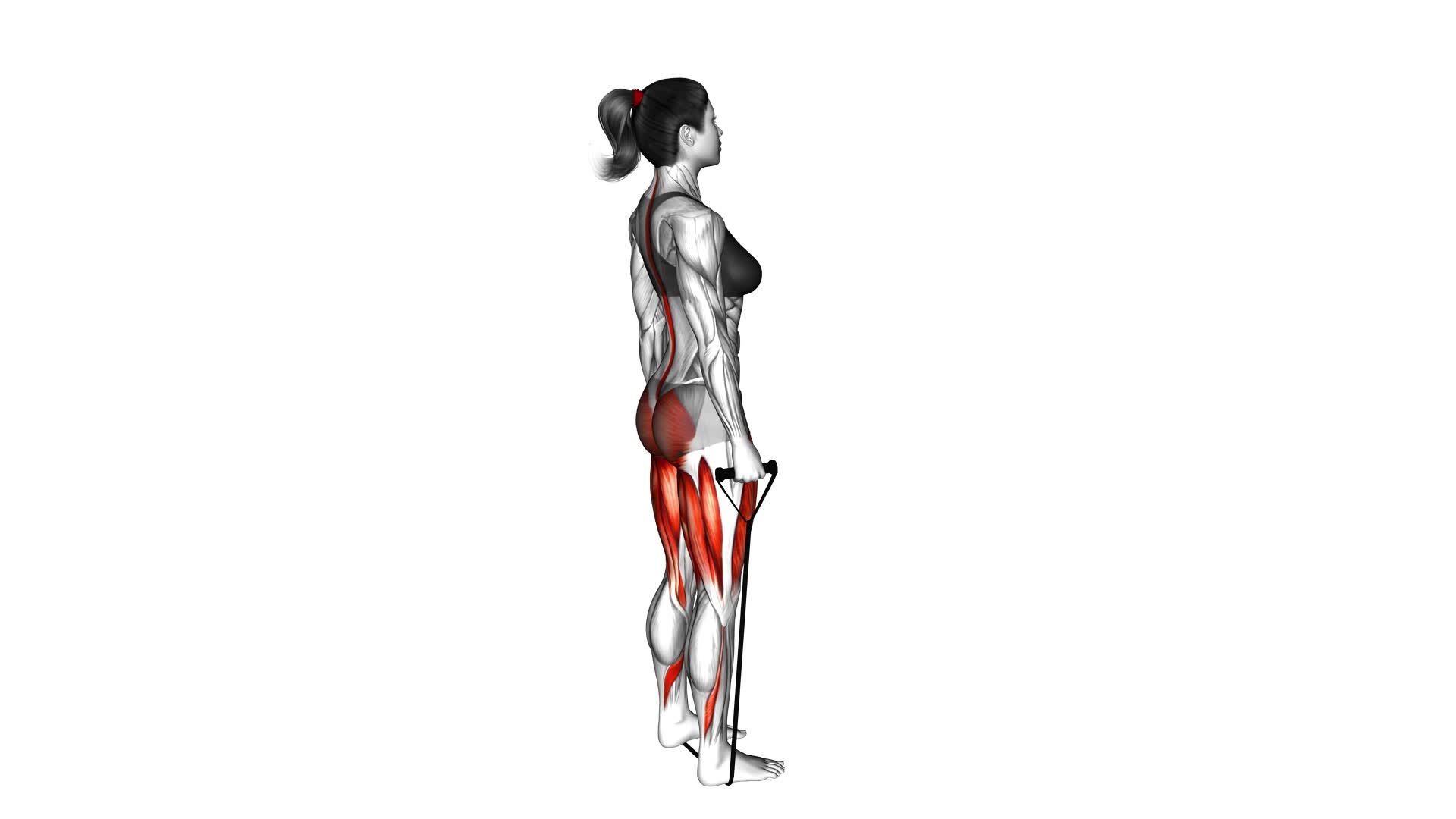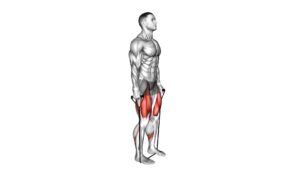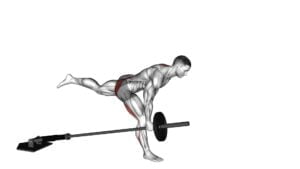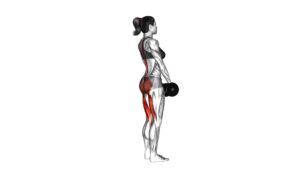Band Straight Back Stiff Leg Deadlift (female) – Video Exercise Guide & Tips

Looking to strengthen your lower body? The Band Straight Back Stiff Leg Deadlift is a great exercise for you. In this video exercise guide, we'll walk you through the proper set-up and equipment needed, as well as provide step-by-step instructions for performing the exercise correctly.
Watch This Exercise Video
Avoid common mistakes and maximize the effectiveness of this exercise with our helpful tips. Whether you're a beginner or an advanced user, we'll also show you variations and progressions to challenge yourself.
Let's get started!
Key Takeaways
- Targets muscles in lower body: hamstrings, glutes, and lower back
- Promotes a straighter and more aligned back
- Enhances posture by targeting muscles supporting the spine
- Strengthens and tones muscle groups
Benefits of Band Straight Back Stiff Leg Deadlift
Discover the numerous benefits you can reap from incorporating the Band Straight Back Stiff Leg Deadlift into your workout routine. This exercise primarily targets the muscles in your lower body, including your hamstrings, glutes, and lower back. By performing the band straight back stiff leg deadlift, you can effectively strengthen and tone these muscle groups, leading to improved overall lower body strength and stability. This exercise also helps to improve your posture by targeting the muscles that support your spine, promoting a straighter and more aligned back.
To incorporate the band straight back stiff leg deadlift into your workout routine, start by attaching a resistance band to a sturdy anchor point. Step into the band, holding the handles with an overhand grip. Stand with your feet hip-width apart and your knees slightly bent. Hinge at the hips, keeping your back straight, and slowly lower the handles towards the ground while maintaining tension in the band. Engage your glutes and hamstrings to return to the starting position. Repeat for the desired number of repetitions.
Now that you understand the benefits of the band straight back stiff leg deadlift, let's move on to the proper set-up and equipment for the exercise.
Proper Set-up and Equipment for the Exercise
To properly set up and perform the Band Straight Back Stiff Leg Deadlift exercise, you'll need a resistance band and a sturdy anchor point. Here are the steps to ensure the proper equipment set up and form for this exercise:
- Anchor the resistance band:
- Find a sturdy anchor point such as a pole or door handle.
- Loop the resistance band around the anchor point and make sure it's secure.
- Position yourself:
- Stand facing the anchor point with your feet hip-width apart.
- Hold the ends of the resistance band with both hands, palms facing your thighs.
- Maintain proper form:
- Keeping your back straight and core engaged, hinge at the hips and slowly lower your torso towards the floor.
- Allow a slight bend in your knees while keeping your legs straight.
- Keep your head aligned with your spine.
Remember, it's important to maintain proper form throughout the exercise to avoid injury and maximize the benefits. Always start with a light resistance band and gradually increase the tension as you become more comfortable with the movement.
Step-by-Step Guide for Performing the Exercise
Now, let's move on to the step-by-step guide for performing the Band Straight Back Stiff Leg Deadlift exercise, starting from the proper set-up and equipment.
- Begin by attaching a resistance band to a stable anchor point, such as a squat rack or pole, at about hip height. Make sure the band is securely fastened.
- Stand facing the anchor point with your feet hip-width apart. Hold the ends of the resistance band with an overhand grip, palms facing your body.
- Engage your core and maintain a straight back throughout the exercise. This will help protect your lower back and maintain proper form.
- Keeping your legs straight, hinge at the hips and slowly lower your torso towards the floor. Allow the resistance band to stretch and provide tension as you lower.
- Pause briefly at the bottom of the movement, feeling a stretch in your hamstrings.
- Engage your glutes and hamstrings to lift your torso back up to the starting position, maintaining control throughout the movement.
Common errors to avoid include rounding your back, allowing your knees to bend, or using too heavy of a resistance band.
If you find the Band Straight Back Stiff Leg Deadlift too challenging, an alternative exercise option is the Romanian Deadlift using dumbbells or a barbell. This movement allows for a greater range of motion and can be adjusted to suit your strength level.
Remember to always consult with a fitness professional before attempting new exercises to ensure proper form and technique.
Common Mistakes to Avoid During the Exercise
To avoid common mistakes during the Band Straight Back Stiff Leg Deadlift exercise, focus on maintaining proper form and technique. Here are three common mistakes to avoid and tips to help you perform the exercise correctly:
- Rounded back: One of the most common mistakes is rounding your back during the movement. This not only puts excessive strain on your spine but also limits the effectiveness of the exercise. To avoid this, engage your core, keep your back straight, and hinge at your hips while maintaining a neutral spine.
- Overarching lower back: Another mistake is overextending your lower back. This can lead to lower back pain and discomfort. Instead, focus on maintaining a slight natural curve in your lower back throughout the movement. Keep your core engaged and your glutes activated to prevent excessive arching.
- Using momentum: It's crucial to perform the Band Straight Back Stiff Leg Deadlift with control and without relying on momentum. Avoid jerking or swinging your body to lift the weight. Instead, engage your hamstrings and glutes to lift the weight smoothly and steadily.
By avoiding these common mistakes and focusing on proper technique, you can maximize the effectiveness of the Band Straight Back Stiff Leg Deadlift exercise.
Now, let's move on to the next section to learn some tips to further enhance the effectiveness of this exercise.
Tips to Maximize the Effectiveness of the Exercise
To maximize the effectiveness of the Band Straight Back Stiff Leg Deadlift exercise, focus on implementing the following tips.
First and foremost, it's crucial to maintain proper form throughout the movement. Keep your back straight, engage your core, and hinge at the hips. This will ensure that you're targeting the correct muscles and minimizing the risk of injury.
Additionally, it's important to use the appropriate resistance band for your fitness level. Beginners should start with a lighter band and gradually increase the resistance as they become more comfortable with the exercise. This will help to gradually build strength and prevent overexertion.
Another tip to maximize results is to focus on the mind-muscle connection. Concentrate on engaging your glutes and hamstrings as you perform the movement. This will increase the activation of these muscles and lead to greater gains.
Lastly, don't forget to breathe! Inhale as you lower the weight and exhale as you come back up. This will help to stabilize your core and provide you with the necessary energy to complete the exercise effectively.
Variations and Progressions for Advanced Users
To further challenge yourself as an advanced user, consider adding weight to the exercise for increased intensity. This can be done by holding dumbbells or using a barbell while performing the Band Straight Back Stiff Leg Deadlift.
Another progression is incorporating single-leg movements, such as the single-leg deadlift or the pistol squat, to target your muscles in a different way and improve balance and stability.
These variations will help you continue to push your limits and make further progress in your strength training journey.
Adding Weight for Intensity
Increase the challenge of the Band Straight Back Stiff Leg Deadlift by incorporating additional resistance for a more intense workout.
Here are three advanced modifications you can try to increase the resistance:
- Use Dumbbells: Hold a pair of dumbbells in your hands while performing the exercise. This will add weight to your deadlift and make it more challenging for your muscles.
- Use a Barbell: Instead of using bands for resistance, you can switch to a barbell. Load the bar with weights that suit your fitness level and perform the deadlift with proper form.
- Use a Weighted Vest: Another option is to wear a weighted vest while doing the exercise. This will distribute the additional weight evenly on your body, making the deadlift more challenging and engaging more muscles.
Remember to gradually increase the resistance as you get stronger to continue challenging your muscles and making progress in your fitness journey.
Incorporating Single-Leg Movements
To further challenge your muscles and progress in your fitness journey, incorporate variations and progressions of single-leg movements into your workouts.
Single-leg exercises are a great way to improve balance and stability, as they require your muscles to work independently.
Start with basic exercises like single-leg squats or lunges, focusing on maintaining proper form and control. As you become more comfortable, you can add weights or resistance bands to increase the intensity.
To further challenge yourself, try more advanced exercises like single-leg deadlifts or pistol squats. These exercises not only target the muscles in your legs, but also engage your core for added stability.
Remember to start with lighter weights and gradually increase as you gain strength and balance.
Incorporating single-leg movements into your routine will take your fitness journey to the next level.
Frequently Asked Questions
How Many Repetitions Should I Aim for When Performing the Band Straight Back Stiff Leg Deadlift?
When performing the band straight back stiff leg deadlift, it's important to focus on proper form and technique.
To get the most out of this exercise, aim for a number of repetitions that challenges your muscles but allows you to maintain good form throughout.
Start with a moderate number of reps, such as 8-12, and gradually increase as you become more comfortable and stronger.
Remember to listen to your body and avoid common mistakes like rounding your back or using too heavy of a resistance band.
Can I Use Dumbbells Instead of Resistance Bands for This Exercise?
Yes, you can definitely use dumbbells instead of resistance bands for the band straight back stiff leg deadlift exercise. Dumbbells offer a great alternative and can provide a different level of challenge for your muscles.
However, it's important to note that resistance bands have their own benefits, such as increasing muscle activation and stability.
Is It Necessary to Warm up Before Doing the Band Straight Back Stiff Leg Deadlift?
Before performing any exercise, it's essential to warm up to prepare your muscles and reduce the risk of injury. Warming up increases blood flow, flexibility, and range of motion, making your workout more effective.
If you don't have access to resistance bands for the straight back stiff leg deadlift, you can use dumbbells as an alternative. Dumbbells provide a similar resistance and help target the muscles in your posterior chain.
How Often Should I Incorporate This Exercise Into My Workout Routine?
To determine how often to include the band straight back stiff leg deadlift in your workout routine, consider your overall workout frequency and exercise intensity.
This exercise targets the hamstrings, glutes, and lower back, so it's important to give those muscles enough time to recover between sessions.
Aim to incorporate this exercise 1-2 times per week, depending on your fitness level and goals.
Remember to gradually increase the intensity as you progress to avoid overtraining.
Can I Still Perform This Exercise if I Have Lower Back Pain or a Pre-Existing Back Injury?
If you have lower back pain or a pre-existing back injury, it's important to be cautious when performing the Band Straight Back Stiff Leg Deadlift. This exercise can put strain on your back and potentially worsen your condition.
It's recommended to consult with a healthcare professional or a qualified trainer who can assess your specific situation and provide modifications or alternative exercises that are safe and suitable for your needs.
Conclusion
Incorporating band straight back stiff leg deadlifts into your workout routine can provide numerous benefits. This exercise is particularly effective for strengthening your lower back, hamstrings, and glutes. It is important to follow the proper set-up and technique to maximize its effectiveness. One common mistake to avoid is rounding your back during the movement, as this can lead to injury. Another mistake to avoid is using excessive weight, as this can also increase the risk of injury. Advanced users can challenge themselves further by incorporating variations and progressions into their routine. However, it is crucial to always prioritize proper form and consult a professional if needed.

Author
Years ago, the spark of my life’s passion ignited in my mind the moment I stepped into the local gym for the first time. The inaugural bead of perspiration, the initial endeavor, the very first surge of endorphins, and a sense of pride that washed over me post-workout marked the beginning of my deep-seated interest in strength sports, fitness, and sports nutrition. This very curiosity blossomed rapidly into a profound fascination, propelling me to earn a Master’s degree in Physical Education from the Academy of Physical Education in Krakow, followed by a Sports Manager diploma from the Jagiellonian University. My journey of growth led me to gain more specialized qualifications, such as being a certified personal trainer with a focus on sports dietetics, a lifeguard, and an instructor for wellness and corrective gymnastics. Theoretical knowledge paired seamlessly with practical experience, reinforcing my belief that the transformation of individuals under my guidance was also a reflection of my personal growth. This belief holds true even today. Each day, I strive to push the boundaries and explore new realms. These realms gently elevate me to greater heights. The unique combination of passion for my field and the continuous quest for growth fuels my drive to break new ground.







